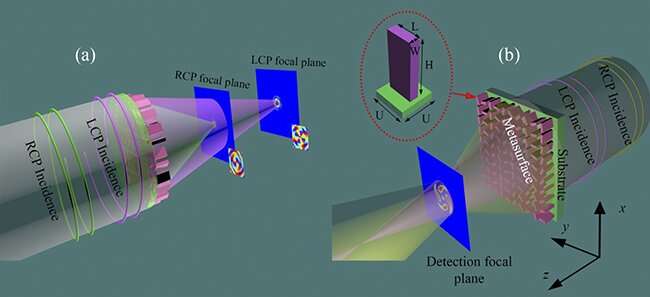Credit: Nano Letters (2023). DOI: 10.1021/acs.nanolett.2c04193
The Fourth Industrial Revolution is driving exponential growth in data transmission, and cost-effective, ultrafast, and compact optical communication technologies are urgently needed to manage the exploding data transmission volume. Vortex beams, which exhibit a swirling shape around the axis of propagation, have the potential to increase the amount of information that can be stored at the same frequency.
As such, they represent a promising avenue for the development of high-capacity optical communication technologies that surpass 5G and pave the way for 6G. To that end, a research team at Pohang University of Science and Technology (POSTECH) has developed a vortex beam capable of functioning with a wide range of light frequencies through the use of a metasurface.
The findings are published in the journal Nano Letters.
Professor Junsuk Rho (Department of Mechanical Engineering, and Chemical Engineering), along with Ph.D. candidate Joohoon Kim (Department of Mechanical Engineering), led the team that proposed a metasurface capable of independently controlling two orthogonal polarization states across the ultraviolet to visible light broadband wavelengths. In addition, the researchers demonstrated the ability to create and detect vortex beams with different topological charges using the metasurface.
Orbital angular momentum (OAM) is a term used to describe the swirling pattern that light takes on as it travels. When light assumes this swirling pattern, it is called a vortex beam. Vortex beams can store more information at the same frequency or polarization state than conventional light beams can.
The independent vortex beam of optical vortex beams has made them an essential tool in optics with various applications, including optical tweezers and creating holographic videos. However, creating optical vortex beams has traditionally required bulky and heavy equipment called spatial light modulators (SLMs). Additionally, introducing ultraviolet optical vortex beams has been challenging due to the lack of SLMs that work in this range.
Recent advances in nanofabrication technology have enabled the realization of high-efficiency, broadband, and multifunctional metasurfaces capable of modulating many light properties, including phase, amplitude, and polarization. However, despite these advances and ongoing research effort, controlling light in the ultraviolet range remains a challenge.
The research team opted for a thin and lightweight metasurface to create a polarizer capable of generating optical vortex beams when exposed to ultraviolet light, as opposed to the bulky and heavy SLMs traditionally used for this purpose. The researchers used silicon nitride, a material with a high refractive index and no absorption of ultraviolet light.
One of the limitations of metasurfaces is that their function is permanently fixed once they are processed, making them difficult to modify. In this study, however, the team broke the rotational symmetry of the metasurface to design it with different functions depending on the polarization of the incoming light. This approach allows for more information to be stored on a single metasurface, opening up potential applications in various fields.
Professor Rho explained, "Our research confirmed the multifunctionality of metasurfaces, which can create optical vortex beams with different topological charges based on the polarization state of the incoming light. The creation of ultraviolet optical vortex beams also expands the potential applications of optical vortex beams."
More information: Nasir Mahmood et al, Ultraviolet–Visible Multifunctional Vortex Metaplates by Breaking Conventional Rotational Symmetry, Nano Letters (2023). DOI: 10.1021/acs.nanolett.2c04193
Journal information: Nano Letters
Provided by Pohang University of Science and Technology
























